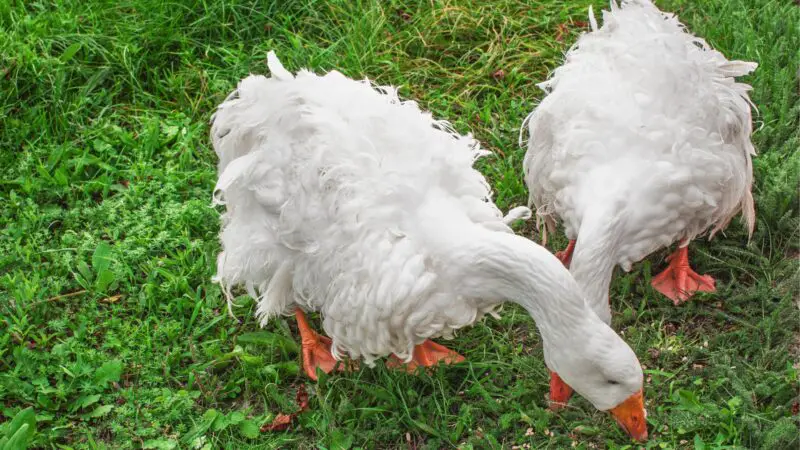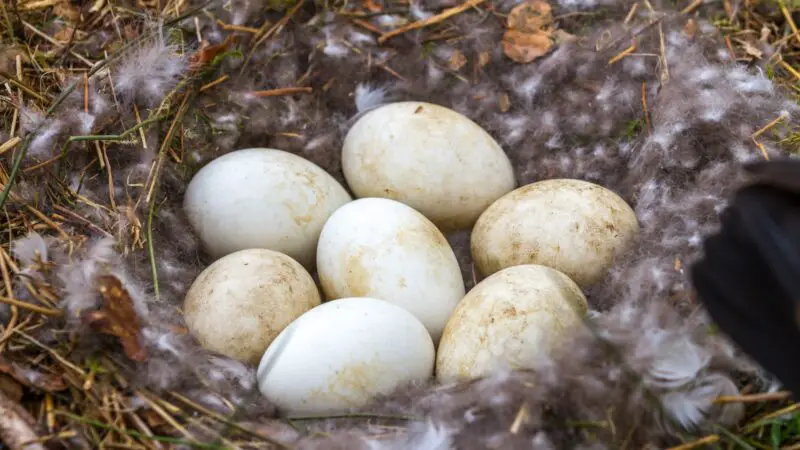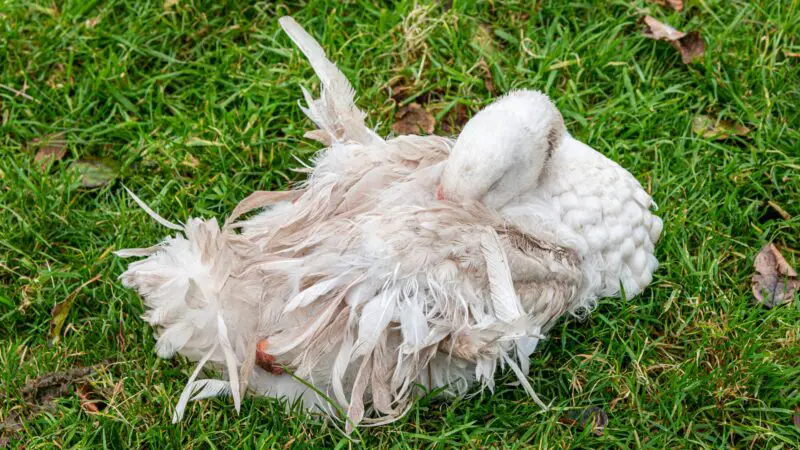Raising geese can be an enjoyable hobby and a profitable business, too. If you plan to have geese, the Sebastopol goose can be a perfect choice.
This goose breed is very unique in several aspects, which makes it one of the most intriguing domestic breeds. It’s no surprise that experienced breeds and even beginners love to try Sebastopol geese.
Sebastopol geese are a breed of domesticated geese that are known for their distinctive, fluffy feathers, which makes them very attractive. The feathers of Sebastopol geese are soft and are used in making high-quality comforters and pillows. They are also a popular choice among farmers who raise geese for show.
There are a lot of great reasons why you should raise Sebastopol geese. Aside from having a controversial history, they are famous for having a unique type of feathers. This old breed has many uses, too.
If you want to know if Sebastopol geese are the right ones for you, this article can help you decide. Read carefully from start to finish.
Sebastopol Goose History

The history of the Sebastopol goose is not certain, but it was believed to have been developed using the Greylag goose, a wild goose native to Europe.
During the 19th century, this domestic goose breed was called in Ireland as Danubian geese. However, the name was later dropped to avoid confusion with the local breed with the same name.
Sebastopol geese first appeared in an exhibit in England in 1860. They are known in Germany as “Lockengans” or “Strupp Guns,” which means “unkempt goose” or “curl-goose.” This is due to their unique frizzled feathers.
The Sebastopol goose was recognized by the American Poultry Association (APA) Standard of Perfection in 1938.
Where Do Sebastopol Geese Originate?
The Sebastopol goose was said to have originated in Sebastopol, the largest city in Crimea, hence the name. Meanwhile, another theory revealed that it was developed along the ports in the Black Sea and the Danube, a historical river in Central Europe that originated in Germany. This goose breed was first imported to the US in the mid-1800s.
Are Sebastopol Geese Rare?

Sebastopol geese are considered quite rare these days. In fact, the Livestock Conservancy listed the Sebastopol goose as “Threatened:”
This means there are only less than 1,000 Sebastopol geese in the United States, with less than seven primary breeding flocks. The current estimated population around the world is below 5,000.
Sebastopol Goose Identification
What Do Sebastopol Geese Look Like?
Sebastopol geese have large, rounded heads, slightly arched necks, prominent blue eyes, and keelless breasts. Some variants may have brown eyes, though.
They have long, curly feathers on their bodies and breasts, while their neck feathers are soft and smooth. They also have long bodies, short backs, well-muscled thighs, and short legs.
The Sebastopol goose comes in white and colored varieties, including Gray, Buff, Blue, Gray Saddleback, and Buff Saddleback. Nonetheless, only the White Sebastopol goose is recognized by the APA.
There are two plumage types – the frizzle and the smooth-breasted. When viewed from above and on the sides, their bodies appear to be round.
How to Tell Male From Female Sebastopol Geese?
It will be quite difficult to tell the difference between male and female Sebastopol geese. Nevertheless, Sebastopol goslings are autosexing with about 80% accuracy.
Newly-hatched male goslings usually have yellow down with a gray saddle over their back and shoulders, while females have yellow necks and are gray from head to tail.
Both adult male and female Sebastopol geese have curly feathers, but ganders have more curly feathers on their tails. Males are also slightly bigger and heavier than females.
Yet, the best way to differentiate males and females is through vent sexing. Female Sebastopol geese have larger vent openings once they have already laid eggs.
What Are the Distinct Characteristics of a Sebastopol Goose?
The Sebastopol goose is the only goose breed with curly feathers and flexible shafts on their body, wings, and tail. Their stylish, twisted body feathers are also longer than the average goose feathers.
Some of them even almost touch the ground. Because of these unique characteristics, Sebastopol geese look larger than their actual size.
How Long Does a Sebastopol Goose Live?
When properly taken care of, the average lifespan of Sebastopol geese is 25 years. Hence, they tend to live longer than most goose breeds.
What Do Sebastopol Geese Eat?
Although some geese breeds are herbivores, Sebastopol geese are generally omnivores. They eat grains, grasses, hays, and seeds but may also eat insects.
During winter, when the grass is not always available, geese may be fed with fruits and vegetables. Egg-laying geese need extra calcium for stronger eggshells and should eat oyster shells.
Cracked corn can also be a cheaper alternative for geese in cold climates but should never be their main diet and must be given in moderation. It should not be fed to goslings.
Corns are high in carbohydrates but low in protein and can cause Sebastopol geese to be obese. Instead of corn, give them sunflower seeds as a food supplement.
How Big Do Sebastopol Geese Grow?
Sebastopol geese are a medium-sized breed. They can grow between 60 and 120 cm (23.6 and 47.2 inches) long.
Are Sebastopol Geese a Heavy Breed?
Sebastopol geese are not considered heavy but rather average. Adult male Sebastopol geese usually weigh between 12 and 14 lbs (5.4 and 6.4 kilos), while adult females can weigh between 10 and 12 lbs (4.5 and 5.4 kilos).
Sebastopol Goose Wingspan
There are no records stating the average wingspan of Sebastopol geese. But since this fluffy goose breed has short wings, they also have a relatively short wingspan.
Are Sebastopol Geese Aggressive?
Sebastopol geese are not aggressive species. On the contrary, they are very calm, gentle, and friendly to humans.
But like other birds, ganders can become territorial, and geese can be a bit aggressive during the breeding season. Nevertheless, their level of aggressiveness depends on the individual. In general, they have a good temperament.
Do Sebastopol Geese Make Good Pets?
Sebastopol geese make good pets. Their pleasant disposition, being easy to handle, and being naturally docile are only some of their great characteristics as backyard pets.
Caring for their curly feathers is also a great time for bonding with them. They are also friendly to pet dogs and cats, especially when they grow up with the same owner.
What Is Sebastopol Goose Known For?
The Sebastopol goose is a multi-purpose breed, which means that they can be used for meat and egg production, as well as ornamental birds. Geese meat is known for having high quality.
However, their carcass is smaller than most breeds, and they are not the best egg layers. Yet, Sebastopol geese have attractive looks that stand out in exhibits.
When Do Sebastopol Geese Lay Eggs?

Sebastopol geese usually lay eggs between early spring and mid-summer. However, most of them start to lay eggs from February until June, which is quite earlier than most goose breeds.
As expected, geese naturally reduce the number of eggs they lay as they age. Yet, they significantly reduce egg production earlier than other domestic breeds.
How Old Is a Sebastopol Goose When It Starts Laying Eggs?
Like most goose breeds, Sebastopol geese usually start to lay eggs once they are 17-24 months old. Nonetheless, some of them reach sexual maturity as early as 9 months old.
How Often Do Sebastopol Geese Lay Eggs?
Sebastopol geese are moderate egg layers and lay about 25-35 large eggs a year. As mentioned earlier, they only lay eggs in the early spring and summer and not all year round.
However, the frequency and exact number of eggs they can lay still depend on the age, quality of feed, and health of the individual geese.
What Color Are Sebastopol Goose Eggs?
Sebastopol goose eggs are white or off-white, and the exact color depends on the specific genetics of the individual goose. It should be noted that the color of the eggshell does not affect the quality and taste of the egg.
Each egg weighs about 162 grams and is around three times bigger than chicken eggs and about twice the size of duck eggs.
Are Sebastopol Goose Eggs Good to Eat?
Sebastopol goose eggs are good to eat and very nutritious. Each egg is around 57% egg white, 31% yolk, and 12% eggshell. It contains about 1,227 mg of cholesterol, 20 grams of protein, 9 grams of fat, and 1.8 grams of carbohydrate.
Goose eggs are cooked just the same as chicken eggs, but some taste a bit eggy.
Sebastopol Geese Common Health Issues

Sebastopol geese are generally healthy animals and rarely get sick if properly taken care of. But like other waterfowl, they are also prone to certain health issues. Their long, curly feathers can also become a disadvantage for them.
Hence, you should know the common health problems that these geese may encounter. Here are some of them:
- Obesity – Sebastopol geese can become overweight if you feed them too much or if they lack space for exercise. Obesity can cause heart disease.
- Parasites – Sebastopol geese can be affected by parasites such as lice and mites. This can cause discomfort and diarrhea.
- Injuries – Since Sebastopol geese are slow movers, they are prone to injuries, such as deep cuts and bruises.
- Infections – Sebastopol geese are prone to respiratory, eye, and skin infections. They can also transmit bacteria to humans.
Sebastopol Geese Care Tips
Sebastopol geese are cold-hardy and can also perform well during hotter months. But then, it does not necessarily mean that raising them does not have some requirements. Again, they have distinctive feathers that can be a concern while taking care of them.
To help you out, below are some useful tips on how to care for Sebastopol geese properly:
- Provide a spacious area so they can graze and roam. Sebastopol geese are not flighty birds, but you should still build a fence against predators.
- Aside from providing a balanced diet of grass and grains, give them small amounts of fruit and vegetables. You can also feed them with supplements with probiotics, such as Manna Pro All Flock Crumbles.
- Sebastopol geese love water a lot. Provide them with an adequate supply of water but make sure to protect them from extremely cold weather.
- Check them regularly for parasites and treat them at once if necessary.
- To keep them happy and healthy, give them a lot of attention and socialization.
- More importantly, avoid their curly feathers from getting dirty and prevent them from matting. Grooming regularly is a must.
Do Sebastopol Geese Go Broody?
Sebastopol geese are broody. In fact, their broodiness goes beyond as they sit on others’ eggs.
They are also great mothers to the point of being adoptive parents to other’s goslings, as well as of other goose breeds. This maternal instinct is great if you are into meat production but can be a burden if you are after producing lots of goose eggs.
Do Sebastopol Geese Fly?
Sebastopol geese don’t fly. Although they are capable of flying at a very short distance and height, they are very unlikely to do so.
Aside from having short wingspan, their long, curly feathers prevent them from flying. Unlike wild geese, domestic geese are generally not strong fliers, and Sebastopol geese are the least flyers.
Can You Eat a Sebastopol Goose?
You can eat Sebastopol geese. Their meat is darker than chickens but they seem to taste better. Yet, the rich flavor tastes more like beef instead of chicken.
Goose meat is also juicier than duck meat. The meat of a Sebastopol goose can be cooked in several ways, such as grilled, roasted, or stewed. In fact, it is often considered a delicacy.
Are Sebastopol Geese Loud?
Sebastopol geese are not considered loud. They are relatively quieter than most goose breeds, such as African geese. Males are usually slightly louder than females, but the difference is minimal.
Goslings also do honk but in a very low pitch. In general, geese will make some noises once they notice something unusual or predators coming closer.
Why Are Sebastopol Geese So Expensive?
There are important reasons why Sebastopol geese are very expensive. Since they are relatively rare, there are only a few breeders compared to the high demand.
These unique geese also have special needs in grooming their long, curly feathers, making them more costly to maintain. Therefore, breeders have no choice but to sell them at higher prices.
